From factory floor to finished product, how the digital age is transforming the mattress industry
BY GARY JAMES
BedTimes spoke with a broad cross section of the industry to uncover how advances in digital technology are impacting the design and manufacturing of today’s sleep products. And we have plenty to report. New research and development tools, cutting-edge plant equipment and processes, and feature-filled finished products provide proof positive that the bedding industry has gone high tech.
In this feature, we discuss sophisticated design software, automated manufacturing equipment, data analytics-driven research and development, and more. Many of these advances were on display in the machinery halls and component showrooms of the biennial Interzum Cologne trade fair held in May 2015 in Cologne, Germany. As you read, mark your calendars for next month’s ISPA EXPO March 9-12 in Orlando, Florida. There you can witness these developments—and a host of other tech-driven innovations shaking up this not-so-sleepy industry.
GLOBAL SYSTEMS GROUP: Innovations in factory efficiency

Gribetz Batch Pro Panel Cutter is a new, patented panel-cutting technology that automates the cross cut and trim functions for quilting production.
With mattress producers facing growing labor costs and a shrinking skilled labor pool, they are especially interested in investing in new manufacturing technology, says Paul Block, vice president of sales strategy and product planning for Leggett & Platt’s Global Systems Group in Carthage, Missouri.
In addition, producers are being presented with more challenging fulfillment demands from retailers, who are requiring faster turnaround on orders and more tailored product and delivery solutions.
GSG provides manufacturers with new technologies to improve production efficiencies and reduce costs to help them cope with “a very volatile, fast-paced and changing global market,” Block says.
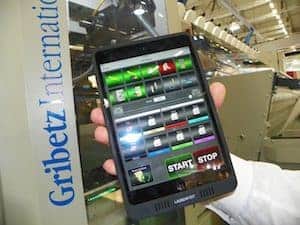
GSG’s new HDMI portable tablet interface is designed to improve quilter operator efficiency. Part of Leggett & Platt, GSG is based in Carthage, Missouri.
As is often true of technology, some customers are “early adopters” who enthusiastically embrace new developments as soon as they are introduced. Others make do with what they have and “play catch up later,” Block says.
“Our customers who are combating these labor and fulfillment concerns by de-skilling processes and improving daily throughput find innovative technologies valuable and accept them sooner,” Block says. “Some of these technologies also make their production faster or more flexible in order to fulfill their customer orders quicker and easier.”
Customers who need diversity in their product line or work at a more “just in time” pace also are more open to investing in new technologies, Block adds, because it gives them a better competitive advantage.
“Today, our customers’ challenges to us are greater than ever,” Block says. “Some of our customers ask us to provide a completely automated factory solution, and others ask us to solve individual factory issues.”
These issues run the gamut, from reducing labor, material handling, work in progress and waste to improving quality and maximizing floor space and productivity. At the same time, the “flexibility, ease-of-use and (maintenance) requirements of equipment are greater than ever as many factories have cut back on service personnel,” Block says.
To help producers address these challenges, GSG continues to develop new technology solutions and tools. Some of the new GSG “smart” devices and software for its Gribetz quilters, for example, allow management to optimize production, set up factory accountability and help assure that machines will be kept up to the maintenance standards required to keep them running efficiently.
One such tool is the Quilter Product Scheduling System. “With proper input, this patented technology automatically prompts the quilting machine to stop for ticking, fill and backing changes and to change patterns without stopping unless a needle change is required,” Block says. “It also stops the quilter for material replenishment and will communicate with a Gribetz Batch Pro Panel Cutter to cut the correct panel length, panel width, number of panels and crop-outs.”
The Gribetz Batch Pro Panel Cutter is a new, patented panel-cutting technology that automates the cross cut and trim functions and communicates with the Gribetz Paragon M series or V-16 quilt machines for batch mode operations. “Together, these two unique technologies communicate to create a truly automated Quilted Panel Production System that is optimized to increase scrap savings dramatically.”
Another recent innovation from Gribetz is Wildstitch. Wildstitch can increase the overall quilting throughput on the Gribetz V-16 and new Paragon quilters up to 25% through the use of patent-pending software techniques, without increasing the stress on the quilters. It will automatically balance the stitching quality and sewing speed by maximizing the software and hardware mechanisms.
Also new is the Gribetz Preventive Maintenance software program that works with the V-16 and Paragon quilters. This advanced program, coupled with wireless material run-out sensors, tool-free material tension devices and a wireless tablet with self-charging case, gives managers, mechanics and operators all they need to maximize production while reducing maintenance issues, according to Block.
GSG recently introduced its new quilter HDMI portable tablet interface for improved operator efficiency. The interface provides full machine operating functionality from a portable tablet, stores machine reference manuals and enables users to show service personnel issues they are having on the machine through online video chat software. “This mobile device frees up the operator to be more productive with multitasking while still maintaining full control of primary quilter functions, and it helps maximize runtime by shortening the time required of maintenance procedures,” Block says.
GSG also offers machinery that helps reduce the lay-up and cut time involved in cutting ticking, fabric, nonwovens and other materials—usually a very labor-intensive process. “The Porter ZipCutter will allow manufacturers to bring cutting in-house and control productivity, costs, inventory and work in process,” Block says. The machine also improves the speed of cutting operations as well as cutting size consistency and cut-edge quality, he adds.
When it comes to implementing new technology, Block advises producers to consider sending technical personnel to a GSG training center for education. “This way, they can get uninterrupted, concentrated information that will set them up for success with whatever machinery or software package they buy from us.”
It also is helpful if producers have WiFi technology available to provide a link between GSG’s service departments and the new machinery, Block says.
FINISHED PRODUCTS: Spearheading ‘quantified sleep’
New technology was evident in a number of beds introduced at last month’s Las Vegas Market, with at least two companies—Serta Simmons Bedding LLC and Kingsdown Inc.—introducing a new sleep-monitoring feature into their lines.
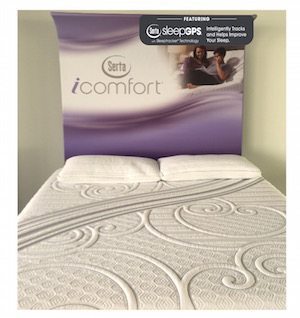
Serta’s new Sleep GPS base features Sleeptracker Technology, which tracks heart and respiration rates, awake time and levels of sleep to provide insights on sleep quality and general wellness. The Serta brand is based in Hoffman Estates, Illinois.
Simmons unveiled the Beautyrest SmartMotion line of adjustable foundations powered by Sleeptracker technology. Serta introduced the same Sleeptracker technology to one of its Perfect Sleeper high-end bases, calling it the Serta Sleep GPS with Sleeptracker Technology. The technology consists of two (in queen and king size) advanced, noninvasive sensors, which are integrated into each side of the foundation and connected to the Internet via a home WiFi or LAN network. These sensors send information about sleeping behavior to the cloud for storage, analysis and retrieval by sleepers on their Android or iOS smartphones.
“The Sleeptracker system will monitor factors such as heart rate, respiration rate, movement, awake time, light sleep, deep sleep and REM sleep and will provide guidance or recommendations on changes in sleep habits,” says Michael DeFranks, vice president of advanced technology at Simmons Bedding Co. in Atlanta. “Data from each night’s sleep will be synthesized to create a daily score that provides the consumer with new insights on sleep quality and general wellness.”
Also introducing sleep-monitoring sensors into its upper-end mattresses was Kingsdown. The sensors reside inside the top of the mattress, capturing information on sleeper activity through a cloud link, which consumers can access through their smartphones.
“At a glance, consumers will be able to see how cold or warm they were during sleep, how often they moved and what their breathing patterns were,” says Kevin Damewood, executive vice president of sales and marketing for the Mebane, North Carolina-based company. “It will help consumers make adjustments to obtain the least interrupted sleep, and the data also will help us gain a heightened understanding of our beds’ performance so we can build even better products in the future.”
ATLANTA ATTACHMENT CO.: Advances in equipment efficiency and automation
Among the new equipment Atlanta Attachment Co. Inc. has introduced recently is Bologna, Italy-based APER’s new 1967-AX-R and AX-R+ lamination and roll-coating machines, distributed in North America as part of a new partnership. Capable of handling plain, convoluted and contoured foams, the AX-R has manual adjustment of roller height while the step-up AX-R+ machine features a height-recognition system that automatically positions the glue-spreading roller above a contoured foam plate. The 1967 AX-R+ also can apply glue only to selected areas of the bed by moving up and down, skipping those areas where glue isn’t needed, reducing material usage. Atlanta Attachment also offers automatic stacking and loading functions that work in tandem with the new AX-R machines. The AX-R+ will be on display at ISPA EXPO 2016.

Atlanta Attachment Co. Inc. is now distributing APER’s new 1967-AX-R+ lamination and roll-coating machine in North America. Designed for plain, convoluted and contoured foams, the machine reduces labor as well as material usage.
“This equipment is computerized and controlled not only to make sure everything is precise and done correctly but also to decrease labor, monitor the amount of glue put into the plate and—something new to this area of the market—apply glue to a true contour foam,” says Hank Little, president.
Also new from Atlanta Attachment is the 1317A, an automatic panel serging and flanging system. Its features include electronic edge guiding, automatic corner sewing and a serial bus control system. “Everybody talks about auto flanging but, in most cases, the operator still loads the panel and guides and follows the panel through during production,” Little says. “With the 1317A, we’ve worked hard to develop a true auto flanger.”
During the past half year, one customer has been testing two of the 1317A machines “with very positive results,” Little says. “They needed to replace their longtime seamstress, who was retiring. Instead of an eight- to 10-week training curve, they had these machines up and running in a day and a half. When you consider the expense of training, plus the labor savings and the improved quality, the return on this investment is pretty compelling.”
Bedding producers are zeroing in on three areas with their current technology investments, according to Little. “They are looking for ways to de-skill the operation, because skilled labor seems to be harder and harder to find; to reduce workers comp issues; and to improve labor savings, as well as throughput.”
As technology continues to transform every aspect of Americans’ lives, “from the way we communicate to the way we shop,” bedding manufacturers and retailers are looking for anything that can help them stay more competitive,” Little says. “The consumer is demanding newer technology and faster, more convenient service and that’s driving big changes in both manufacturing and marketing. Everyone is looking for an edge to make their products better—or to make their operations more efficient.”
SERTA SIMMONS BEDDING LLC: Creating the factory of the future
At Atlanta-based Serta Simmons Bedding, a multiyear project launched in 2015 is transforming the two bedding majors’ legacy plants into “factories of the future,” says Mike Hofmann, executive vice president of research and innovation. It involves two key initiatives—the implementation of a manufacturing execution system to better manage and monitor work in progress on factory floors and the adoption of more robotics to improve material handling during production.
“We have piloted a new MES at one of our facilities in 2015 and are in the process of finishing the rollout at a second site with plans to expand the system to more plant floors in 2016,” Hofmann says. “This computerized system enables us to more closely track and document raw materials as they move from a component state into the finished product. Our line is very complex and this new approach will help us make sure we are putting the right products in the right order throughout the entire build process.”
The adoption of manufacturer execution systems works hand in hand with the second initiative underway at Serta Simmons Bedding plants, the integration of more robotics on plant floors. To speed production and reduce the need for humans to handle heavy loads, the company is implementing new robotics that provide pick-and-place positioning of toppers and innersprings. In addition, new robotics are being used for gluing.
“These two initiatives—robotics and MES, working in tandem—will enable us to improve accuracy on the plant floor, which we expect will reduce mistakes, improve quality and generate a higher first-pass yield on goods in production,” Hofmann says. “We’ll know exactly what’s going into each product, which will reduce waste and downtime and speed setup times and production runs.” With robotics handling more of the heavy lifting, injuries also should be reduced, he says.
Serta Simmons Bedding is taking this program on in stages, “because there’s a steep learning curve with any big change,” he says. “Today, our manufacturing environments are manual, with quality and processes controlled largely by individuals. Now we’re trying to have system-level quality, which requires everybody—the floor associates, machines, mechanics and supervisors—to be on the same page.”
It’s a continuous learning process, not without its challenges, he adds. “But we expect the new technology to have big payoffs for us down the road, in both product quality and productivity.”
FXI: New R&D technology for better foams
Foam producer FXI opened a 30,000-square-foot Research and Innovation Center in Aston, Pennsylvania, in 2012. There, the company uses cutting-edge thermal testing equipment and protocols that its team created for use in healthcare product development, where climate management is essential to the prevention and treatment of bed sores.

FXI’s investments in a cross-functional mix of marketing and product development experts, chemists, engineers and technicians, as well as manufacturing and testing equipment, mean “that our customers can rely on us for high-quality consistency and performance,” says Jacqui Griffith, senior director of marketing and product development for the Media, Pennsylvania-based company.
KINGSDOWN: Putting data to work
While mattress maker Kingsdown’s bedMATCH diagnostic system has been helping consumers determine the mattress best suited to their needs since 1999, the data collected by the technology has proven to be a big asset to the company’s product designers and marketers, says Kevin Damewood, executive vice president of sales and marketing for the Mebane, North Carolina-based company. To date, the system has collected more than 9.5 million profiles, providing a treasure trove of information about consumers’ body types, health challenges and sleep preferences.
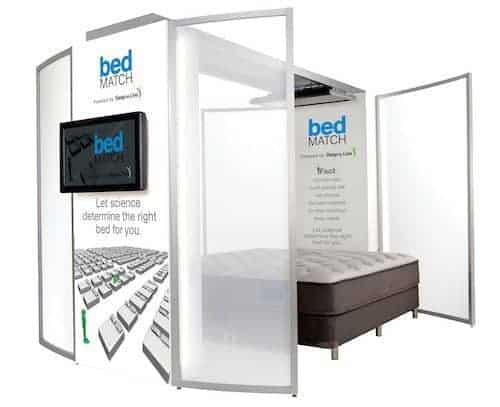
The Kingsdown bedMATCH in-store diagnostic system has been generating a wealth of valuable data for use in product design and marketing.
When consumers test a bed in a retail store using bedMATCH, they enter basic physiological and sleep habit information into the confidential bedMATCH portal. Using that information, combined with 18 statistical measurements and more than 1,000 calculations, bedMATCH then identifies the optimal postural support and pressure relief for individuals. A color-coded mattress recommendation is printed, directing consumers to a select number of mattress models — from gold (plush support) and green (medium-plush support) to blue (medium-firm support) and red (extra-firm support).
“Data captured by the bedMATCH system are constantly being added to our database, so the more people who use the bedMATCH system, the richer the data gets,” Damewood says.
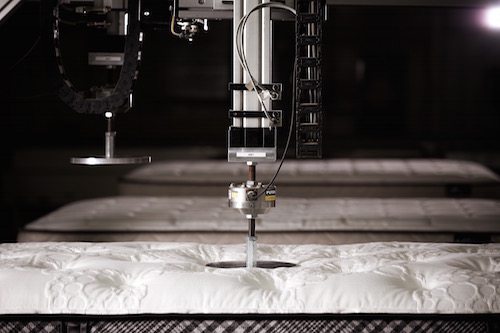
Mebane, North-Carolina-based Kingsdown uses an ICSA machine to test every mattress it produces to make sure it has the correct level of support prior to shipment.
The data provides valuable insights on a variety of fronts. “Most of the industry assumes that the mattress-buying decision is predominantly driven by females,” Damewood says. “As a result, a lot of the sales strategies used on the retail floor are targeted to women. But we’re finding that the gender mix of the 9.5 million people we’ve profiled while shopping for beds is almost a 50-50 split. That means we have to talk to both genders in our marketing.”
Another key finding: 62.5% of people profiled complain of lower back pain and another 26.3% complain of midback pain. “That means that almost 80% of shoppers coming into a sleep shop suffer from some type of back pain,” Damewood says.
This stat should be a wake-up call to the industry, Damewood adds. “Over the years, many RSAs have switched their emphasis from selling support to selling comfort. But comfort selling often results in an RSA convincing the consumer that a softer mattress is better for them. And that accentuates back pain, because you have to have the proper support before anything else.”
Responding to a need identified by its data for more back-friendly beds, Kingsdown introduced a new line called BackSmart at last month’s Las Vegas Market. Priced from $2,199 to $4,999 suggested retail for a queen size set, the line features anatomically designed foams and lumbar support to keep backs in better alignment.
Based on the data provided by bedMATCH profiles, Kingsdown has found that most people need a firm mattress—35% of those profiled need medium-firm and another 29% need extra-firm. Medium plush is recommended to 22%, and the remainder is recommended plush.
“This data has taught us that support is very important to delivering quality sleep and relieving back pain,” Damewood says. He adds that Kingsdown has taken this information “and combined it with our science to develop better insights into what level of support is needed to get specific back types into proper alignment. Our science has taught us to build precisely to the ‘50-yard line’ of each of the four support ‘buckets’ and pressure-relief standards.”
Because the density and consistency of foam provided by suppliers can vary, Kingsdown carefully tests all its raw materials at the front end of the manufacturing process to ensure it is building a “true medium-firm or plush mattress,” Damewood says. In addition, Kingsdown uses a computer-controlled Inline Comfort Support Anaysis machine to test every finished bed with pressure to make sure that is built to the right level of support. “A platen slowly is depressed into the mattress to measure the level of support, and the bed either passes or fails. If it fails, it doesn’t ship. We now test every mattress that comes out of our factories,” he says.
MAQUINOL INTELLIGENT MACHINERY: Foam beds for DIY-ers
Maquinol Intelligent Machinery’s ColMat Exacto system is a mattress production line that allows smaller manufacturers to automatically dose, mix and pour their own mattress cores in a variety of profiles. Operated by touchscreen, the machine is fully automatic and equipped with Maquinol software for programming and recording formulas and production parameters.

Maquinol Intelligent Machinery’s new ColMat Exacto molded mattress production line is shown as a rendering. Maquinol is based in Estarreja, Portugal.
The all-in-one solution comes equipped with a 40-kilogram stainless steel transfer for final mixing, a 2000-kilogram Polyol tank and a 1000-kilogram ISO tank, all with individual temperature control and load cells for dosing. The line also includes six molds and mold carriers and a mold press.
“This system allows manufacturers to design and produce molded mattresses with an infinity of characteristics—they only have to imagine it,” says Sumya Diaz, sales manager of the Estarreja, Portugal-based company. “It’s a small production line that allows you to adjust the density of the foam for a high-end, latex-like foam feel.”
The main advantages of this new technology are its improved production process, significantly lower cycle times and ease of operation, Diaz says. “These improvements translate into lower production costs for mattress manufacturers.”
He adds that the ColMat Exacto, like all of Maquinol’s machines, is equipped with the Exacto Dosing System, which provides automatic dosing of products by weight, ensuring high reproducibility and reliability.
FINISHED PRODUCTS: ‘Foundational’ technology
As consumers’ desire for adjustable levels of support rises, new technologies are emerging to help bed producers deliver a more responsive sleep experience. They include two new systems introduced at the Interzum Cologne 2015 show — Starsprings’ s-matic line and Custom8 Intelligent Bedding Components’ r-Leaf system.
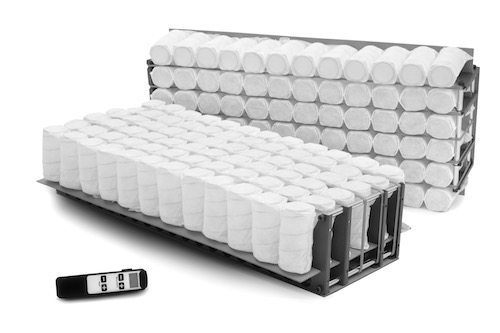
Starsprings’ new S-matic line uses a system of pop-in cassettes with five braided cords and a wireless remote to enable sleepers to adjust bed firmness. Starsprings is based in Herrijunga, Sweden.
Starsprings’ new s-matic line features a system of one or two adjustable, motor-powered cassettes, each of which contains five, 12-braid Dyneema cords treated with polyurethane for durability and flexibility. Placed into a wooden bed frame or integrated directly into the bottom layer of a mattress, the system uses a wireless remote to tighten or loosen the cords, enabling sleepers “to create the perfect spine position” in one or two zones, said Johan Dahlin, sales and marketing manager of the Herrijunga, Sweden-based company.
The Zone version of the product adjusts the hip and shoulder zones; the LS model adjusts lumbar support. A third version—Auto—delivers automatic adjustments by detecting changes in body position.
“The potential for this line is huge,” Dahlin says. “Adjustable sleep is already an important element in the U.S. market and it’s quickly becoming a global trend, as well. We expect to be producing the s-matic on a very large scale within the next two years.”
Dahlin adds that the original prototype of the product has been enhanced so that the cassettes now can be placed anywhere in the mattress. “Producers can now use our system to build a bed in line with their own design needs and brands,” he says. “They have the freedom to place the cassettes anywhere they like to optimize support and comfort.”
According to Dahlin, the s-matic delivers the correct spine alignment for sleepers in any position and for any body type, minimizing pressure on hips and shoulders. “It’s a simple, affordable solution that offers a single sleeper or partners the ability to adjust their beds based on their unique needs. And if those needs change, they can easily be adjusted for more or less support.”
Also making a splash at Interzum 2015 was Custom8, which introduced an adjustable slatted base concept called r-Leaf. Promoted as an “active slat module,” r-Leaf automatically adjusts slat tension (or stiffness) in as many as eight zones of the foundation during sleep for improved body alignment and comfort. The modular concept of the r-Leaf permits the unit to be used in a box spring foundation.

Custom8’s new r-Leaf system is an ‘active slat module’ that automatically adjusts slat tension or stiffness in as many of eight zones of the foundation during sleep. Custom8 Intelligent Bedding Components is based in Heverlee, Belgium.
The patented module consists of a double slat system in which the upper slat is supported by the lower slat by means of coupling elements. The stiffness of the upper slat is adjusted by a motor that moves a pair of sliders over the lower slat, extending or limiting the cantilever motion and, thus, the bed’s stiffness. A built-in sensor mat reads changes in sleepers’ body positions to adjust firmness. Sleepers also can make their own adjustments via a remote.
“Unlike other adjustable bed bases, the upper slat of each module always returns to the same height when unloaded,” says Hans Druyts, chief executive officer of the Heverlee, Belgium-based company, which has been conducting engineering and medical research in partnership with the University of Leuven in Belgium since 2001. “The entire unloaded slat surface remains perfectly level, independent of the stiffness setting of each module.”
Druyts adds that firmness can be adjusted from “very firm to very soft,” delivering proper support and comfort to “every type of sleeper.”
Currently in discussions with several leading producers in Asia, Europe and the United States, Custom8 has designed its system to work with a wide variety of bed models. “ ‘Smart’ beds are going to become more and more important,” Druyts says. “If the ultimate goal is to optimize sleep quality, consumers need to have a bed that automatically adjusts throughout the night to respond to changes in body position and other key parameters.”
Druyts adds that mattress companies are adopting Custom8’s new r-Leaf technology in their sleep research labs for use in the development of ergonomically optimized sleep systems and smart beds.
BRIGHI TECNOLOGIE ITALIA: Smarter pillow production
Brighi Tecnologie Italia’s new MAC4 system, introduced at Interzum Cologne 2015, evolved out of requests from the upholstery industry for an accurate, fast machine that could weigh and blow filling material into multipocket cushions. After succeeding in developing a solution for upholstery—MAC3, with three preweighing chambers and one blowing station—the company set about making similar equipment for the sleep products industry. The result was the MAC4 pillow-filling line, with four pre-weighing chambers and two blowing stations.
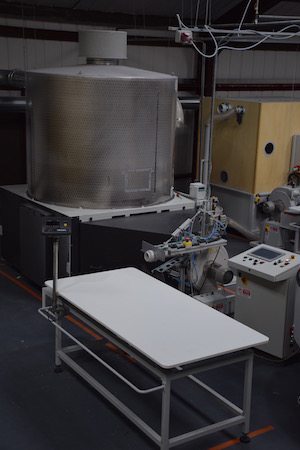
Similar in look to the MAC3 model shown here, Brighi Tecnologie’s MAC4 system is an automated pillow-filling line with four pre-weighing chambers and two blowing stations. Brighi is based in Forlì, Italy.
Designed to work with any raw material, including feather and down, fiber and microfiber, shredded foam, latex, wool and any blend or combination of those materials, the MAC4 is the “preferred system for throw and sleeping pillows where you have a repetitive weight, lower filling amount and size,” says Matteo Tagliaferri, export sales manager of the Forlì, Italy-based company.
“What makes our system innovative is the custom-designed software, which gives the manufacturer the ability to design a cushion directly on the screen in a very intuitive and quick way,” Tagliaferri says. “The color-coded areas on the working grid can be shaped to resemble the actual product, and the operator can easily assign to each of them all the desired parameters, such as weight, blowing speed and filling product. The extended-size memory can hold innumerable combinations for all the manufacturer’s product range.”
The two new systems are very user-friendly, Tagliaferri adds. “Once the data are loaded, the operator just follows a sequence—the software manages everything else.”
According to Tagliaferri, the machine’s preweighing chambers have outstanding accuracy—much less than 1% average weight discrepancy. This, combined with the specially designed blowers and nozzles, offers a quick, clean solution for the pillow-filling process.
The company plans to continue to enhance current equipment to improve efficiencies and to introduce new equipment designed to more fully automate processes that currently are semi-automatic. “As a company, we always strive for innovation,” says owner Alessio Brighi. “Our goal is to continue to offer innovative solutions that have never been done before and, even for the most common processes, offer a different and better-performing way to do it.”
FABRICS AND FIBERS: New apps fuel creativity
Bekaert Textiles debuted its new design collaboration app—Imagine—at Interzum Cologne 2015. Created using a mixture of software developed in-house and technology developed by the gaming industry, Imagine provides Bekaert’s customers with a “faster prototyping experience with decreased development and manufacturing time,” says Amber Knight, a designer with Bekaert Textiles USA in Winston-Salem, North Carolina.
“With Imagine, we can simulate realistic fabrics, colors and designs specifically for each customer onto customizable 3D bed models,” Knight says. “Once designs and colors are approved, then the necessary fabrics can be manufactured.”
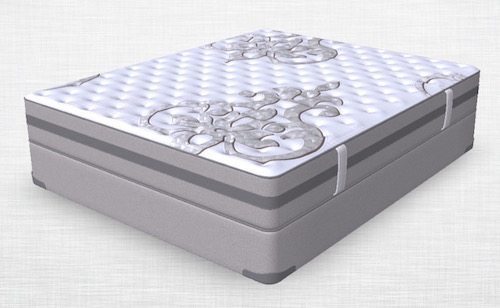
Bekaert Textiles’ new Imagine design collaboration app created this bed model. Bekaert Textiles USA is based in Winston-Salem, North Carolina.
Because Imagine is a sophisticated app, users require training to learn how to create 3D bed models, as well as to apply simulated fabrics, colors and accents. Bekaert offers this service to all its customers as a prepared package that is delivered and ready to review. “With this technology, we ensure that our customers receive exact specifications and needs without requiring them to be involved in the technical process,” Knight says.
According to Knight, Bekaert’s customers have had a “great reaction” to Imagine. “Our customers have responded very well to the presentation abilities that we have with Imagine—showing detailed simulations of fabrics, color options and realistic customized beds all in one package. The bed simulations are realistic enough to give customers confidence in making fabric and finished mattress decisions.”
Bekaert plans to showcase the Imagine app at ISPA EXPO 2016 March 9-12 in Orlando, Florida.
At last year’s Interzum, DesleeClama’s Innovations & Design Centre launched its second-generation digital tool, iDC Designer Software. An evolution of its iDC Cloud App, introduced earlier in 2015, iDC Designer Software enables bed designers to create custom covers based on their own specific needs and preferences. Elements such as mattress height, width, thickness, shape, quilting patterns, and border and zipper types all can be separately chosen and programmed to create a customer-specific mock-up. This mockup then can be uploaded in the iDC Cloud App and dressed up with all the fabrics available from DesleeClama.
“Where the iDC Cloud App contained preset mattress mock-ups based on the most common zipper, topper and mattress models in the market, the iDC Designer Software allows our customers to create a detailed simulation of the specific mattress models they want to commercialize,” says Craig Dunlop, president of DesleeClama North America in Inman, South Carolina. “It also helps them to modify or make changes before the production process has started.”
According to Dunlop, designers can instantly simulate any mattress with the practical iDC app. “Simply select your mattress design, quilt patterns and your preferred panel and border fabric,” he says. “Then add and modify zippers, tape edges and whatever other personal touches you would like. After that, you can zoom in, drag and rotate to view your creation and fabric mixture in meticulous detail.”
Once a new bed design is created, it can be pushed online to the iDC Cloud App for sharing with approved users. The iDC Cloud App is accessible from any device with unlimited content and an easy log-in via the website. The app also contains trend insights, marketing brochures and other “must-haves” for use by DesleeClama sales managers and their customers.
DesleeClama opened the Innovations & Design Centre at its headquarters in Zonnebeke, Belgium, in 2012. The center serves as the hub for all the company’s design, development, marketing and engineering activities.
Natural fiber and filling source Enkev Natural Fibres, with headquarters in Volendam, Netherlands, introduced two proprietary apps recently to aid the design process. The first, shown at Interzum Cologne 2015, is a new app for customers that demonstrates how to work with its diverse line of natural products.
“We want to help potential customers realize that it can be quite easy to work with our products, and the process is no different than with foam and fiber, which will always have a place, too,” says Matt Dwyer, sales director. “This new app helps them gain a much finer understanding of the characteristics of our products. It’s all about providing more information about why we perceive natural to be the best.”
Enkev’s website also serves as a key destination for information about products, raw materials and processes. The “Products” landing page, for example, features a clickable grid of nearly 90 links to landing pages for information about everything from alpaca and wool to silk and hemp.
In addition to these tools, Enkev also has developed a new app for its own use that allows product designers to create mattresses using a range of fillings. “Anything up to around four layers per side is possible, using a range of our fibers,” Dwyer says, adding that the app also can be used to create spring/foam products or “other Enkev-type product cores.”
C3: Automating materials handling
C3’s Pick-and-Place Gantry, a system introduced in 2015, is designed to automate the movement of unfinished mattresses and foam components or finished mattresses that are ready to ship. Built with three axes of motion, the system runs on a track of unrestricted length, with the capability of moving product up to 300 feet per minute. The gantry’s side-to-side reach is 80 inches in both directions and the system can extend vertically to about 30 feet. The shuttling carriage can be customized to serve a variety of specific “pick” points.

C3’s Pick-and-Place Gantry offers an alternative to conventional pallet-based material handling systems. C3 is based in Appleton, Wisconsin.
“The gantry system replaces forklifts or automated guided vehicles and allows manufacturers to use floor space in better ways,” says Joe Van De Hey, founder and chief executive officer of the Appleton, Wisconsin-based company. “Thanks to the gantry’s reach, it can extend material storage from floor to ceiling in many cases and sometimes double or even triple capacity.”
This technology also is helpful for just-in-time or first-in, first-out order fulfillment. “Automating material handling allows a facility to use their staff in more cost-effective areas. It creates better work flow and reduces the opportunity of human error,” Van De Hey says.
According to C3’s studies, up to 50% of downtime is caused by inefficient material delivery, Van De Hey says. “In other words, machines are idle and waiting for material. Our gantry system provides just-in-time access to inventory information—and enables better decisions regarding production scheduling.”
In addition to its new Gantry system, C3 also has been expanding its line of mattress compression and roll-packing machines. At ISPA EXPO 2016 March 9-12 in Orlando, Florida, it will introduce CF1596, a new compression and roll-packing machine designed for innerspring products. The company also offers several other machines that laterally and vertically compress foam beds for boxed shipping.
“With today’s new equipment, producers can place a quality mattress into a compact package and ship it directly to the consumers within a matter of days,” Van De Hey says.




